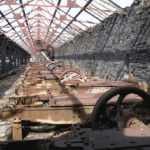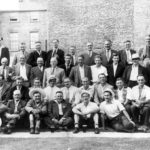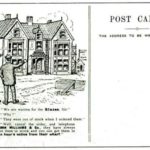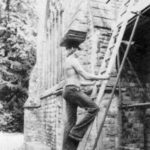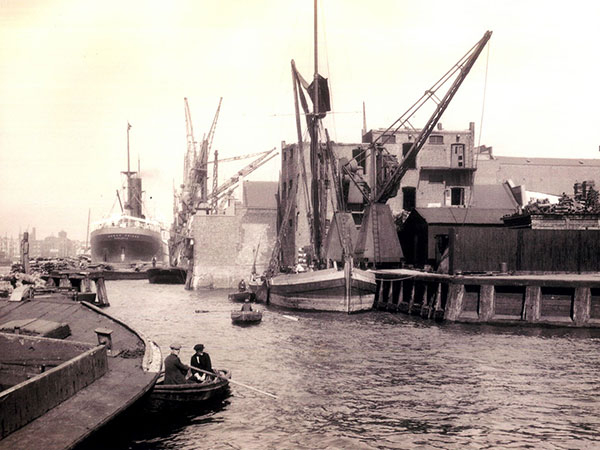 The History of John Williams & Company
The History of John Williams & Company
Pre 1870
John Williams & Co can be traced back to 1870 but there are suggestions that it could date back to 1822 with a ‘Williams’ in Bangor.
The Greenwood family were associated with the company from 1890 until 2004 and it is often asked why if the family name is Greenwood is the company called Williams. One story is that because the company was predominately associated with the Welsh slate industry a solid Welsh name was required – hence ‘Williams’. However, when asked about this John Greenwood, who was the last Chairman and Managing Director thought that his family might have purchased the business from a Mr Williams of Bangor. There is a tantalising line of enquiry thrown up by adverts c1845 regarding the Williams Patent Ridging. An advert in the Cambridge Advertiser dated 1844 relates to Williams Patent ridging ‘manufactured by the patentee at Port Penrhyn, Bangor’. We know that JW & Co had a facility at Mold Junction Bangor – is this the same? There is also an entry in the Civil Engineer & Architects Journal 1845 which describes the Williams ridge with drawings. Could this be the link back as far as 1822? – Lots more research will be required before this could be proven.
1870
In the Whitakers Red Book of Business published in 1907 the entry tells us that JW & Co was established in 1870 especially to transport slate from the Dinorwic slate quarries in North Wales. At that time the principle was Joshua James Greenwood, the entry lists the ‘late principle’ as Alfred Leader. John Williams & Co are described as being distributors of Welsh slate as well as manufacturers of slate products such as electrical switch boards, window cills, door cills and mortuary slabs as well as many other forms of architectural slate. The article also states that John Williams & Co manufacture the Williams Patent Slate Ridging.
At that time the company transported slate from the Dinorwic quarries by barge from its dock in Bangor to its main distribution point at Dinorwic Wharf Rotherhithe. The company also had wharfs at Newhaven Quay, Whittle’s Wharf Faversham, Crown Wharf Chelsea and Southampton Docks. The Yard at Rotherhithe Street had its own stable and horses were used to pull cart loads of slates around the streets of London. Unfortunately animal welfare was poor in those days and most of the horses were recorded in the company records as dying from twisted guts due to hauling overloaded carts.
In the early 19th Century roofing and building materials generally were dictated by the local availability of materials. In London, Kent and East Sussex there were numerous small works producing clay tiles and bricks whereas in West Sussex, Horsham Stone was a common roof covering. Slate from Wales was transported by barge to all major ports and as the development of the railways made transport easier the slate trade boomed. Welsh slate is said to have roofed the world.
1892
Prior to 1892 the slate industry was represented by a number of fragmented trade associations and in 1892 a meeting took place in York of 40 slate merchants and slaters with the object of forming a national association – this was the embryo of the National Federation of Roofing Contractors.
In 1893 the first AGM was held in Leeds of The National Association of Slate Merchants Slaters & Tilers and the London Association of Slate Merchants and Master Slaters. In October the same year a meeting was held at the Charing Cross Hotel, London which was attended by 11 London area slate merchants and slaters who formed the London regional branch of the national association and another meeting in November to form the independent London Association of Slate Merchants Master Slaters & Tilers to cooperate with the national association. J. J. Greenwood represented John Williams & Co at the inaugural meeting at the Charing Cross Hotel, and his name appears on the original hand written notes of the meeting. The name was changed in 1943 when the London Association of Slate Merchants Master Slaters & Tilers merged with The National Association of Slate Merchants Slaters & Tilers to become known as The National Federation of Roofing Contractors. The NFRC remains the principle trade association for the roofing industry and in 2017 (its 125th anniversary year) it recognised JW & Co as the oldest member company of the association, something that we are rightly very proud of. John Williams & Co have paid an active part in the NFRC over the years with our Chairman holding the office of President of the NFRC during two very important periods covering both World Wars. JJ Greenwood was President from 1915 – 1923 and E Greenwood was President from 1938 – 1943
In the early years the company was involved in the manufacture of cement and plaster of Paris as well as being slate merchants, marble merchants and contractors. The rise and popularity of clay tiles mainly due to their more colourful appearance and diverse shapes together with economy saw the company diversify into the manufacture of clay tiles in 1931 with a tile works ‘Greenwoods Tileries Ltd’ based at Barton upon Humber. The ‘Greenwood’ pantile is still manufactured today and occasionally we will find other tiles with John Williams & Co Rotherhithe embossed on the back. Greenwood Tilery was listed in ‘A Snapshot of Barton upon Humber in 1939’ at 117 Maltkiln Road. The exact location of the clay pit etc is shown on the map and is now part of the estuary nature reserve and a SSSI.
In 1937 Greenwood Tileries Ltd took legal action in respect of serious damage which was caused to its operation as the result of flooding caused by high tides breaching the sea defences. This case is notable because it set a precedent and is still quoted today in case law. The action resulted in a ruling concerning what is an ‘act of God’ and it states that the effects of a natural event which could and should have been reasonably predicted cannot be classed as an ‘Act of God’. In respect of high tides, Justice Branson, in Greenwood Tileries Ltd v. Clapson (1937), observed as follows: “I do not think it is possible to say that this tide was so high and unexpected and incalculable as properly to fall within the definition of an act of God”.
The tile manufacturing business was taken into the ownership of Goxhill Roof Tiles, then Sandtoft Roof Tiles and more recently Weinenberger although Greenwoods Tileries Ltd & Barton Tileries Ltd remained registered as fully owned subsidiary companies of John Williams & Co Rotherhithe Ltd into the 1980’s. The Barton clay pit remained in the ownership of John Williams & Co Ltd and company accounts show that royalties for the extraction of clay were still being paid up until 1976.
Notable tiles manufactured by Greenwoods Tileries Ltd and Barrow Tileries Ltd were the Greenwood Pantile, The Greenwood Roman tile and the Gaelic tile.
John Williams & Company Rotherhithe Ltd was incorporated in 1931
Slate sales and contracting from our Rotherhithe depot expanded rapidly and in the 1980s the prestigious Nelson House in Rotherhithe Street was rented to provide additional office capacity while our premises at 167 Rotherhithe Street was predominantly warehousing and yard storage. The company expanded across its branches to become one of the largest roofing contractors in the country employing 150 staff. Competitors at our height included such notable names (all of which have now disappeared) as Roberts & Burling, Roberts Adlard and Hall & Co. It was not uncommon for larger contractors to promote themselves by having their names stamped onto the back of roof tiles or to have their initials stamped on the head of roofing nails. It is not uncommon for us even now to strip old roofs and find John Williams & Co Rotherhithe on the tiles or JW&Co on the copper nail heads – a lovely touch which is sadly missing today. One of the most iconic slating contracts undertaken over the years was the re-slating of Tower Bridge in 1951in preparation for the Festival of Britain. Other notable jobs include the re-roofing of the Royal Chelsea Hospital, St. James’s Palace, The British Museum, Rochester Cathedral to name but a few.
In addition to roof slating and tiling the company also has a long history in the supply of glazed wall tiling. There was a shop at Worthing which also contracted, a contracting department at Rotherhithe (JW Ceramics) and in 1979 a new fully owned subsidiary company Southern Tile Distributors Ltd was set up in Bedford to distribute glazed tiles imported from Italy & Spain throughout the South of England. Glazed tiles were also distributed from our Lympne depot for a short period of time. We also found an advert for wall tiling being sold from our Dover branch as early as 1948. None of these operations were very successful in the long term and were all either closed or sold off.
The period following World War II saw a huge opportunity for both roof tile manufacture and contracting. The South and South East of the country was very badly damaged during the war years and to exploit the opportunity presented JW & Co opened branches in Dover and Worthing. The Dover branch was opened around 1946 at 46 Northampton Street – this is now within the car parking area of DeBradelei Wharf following major reconstruction work in the late 1970’s early 1980’s which saw the Snargate Street area road system redeveloped and Northampton Street fall under the bulldozer. The branch at Dover traded as John Williams & Company Dover and mainly consisted of site work on new buildings for most of the major developers, domestic reroofing work, contracts for schools, NHS and local authorities as well as historic buildings such a churches and castles. This was a very successful operation and local newspaper articles detail many contracts secured by the company for schools and local authority housing projects.
Roofing has traditionally been a trade which has been passed down through generations and JW have had many examples of this. Ernie Mack who retired in 2009 has identified members of his family in the works outing to Margate photograph 1954 – his father Fred, and uncle Tommy. As well as these there were also another four members of his family who worked for JW & Co – Len, Roger, Eileen & Ben making a total of seven over three generations.
The outing to Margate was reported to be the last of these particular events for some time – there are two stories that circulate about the reason for this. One is that the throwing of beer bottles from the rear window of the coach didn’t go down well with the local constabulary while the other story suggests that it was something to do with someone being sick over the chairman’s son. However, outings and social events remain an important part of the company ethos and in recent years has included golf, fishing, karting, coach trips, greyhound racing and dinners.
The premises at Dover were rented from the Dover Harbour Board and when in the mid 1970’s it became obvious that the area was likely to be re-developed JW & Co started looking for other premises. In 1975 a builders yard became available in Lympne near Hythe – Roland Harman Builders Ltd was an old established and well respected local builder which had fallen upon hard times and gone into liquidation. The large shed was originally the carpenter’s shop of Mr Idenden, carpenter and undertaker – there is a tablet to his wife in the Church as she was the organist for many years. It is said that the hessian covered table that was used for cutting glass, which still exists in ‘Ian’s shed’, was cut down from the original undertakers table – how true this is we don’t know.
Although the company moved to Lympne in December 1975 it was some years later before the name ‘Dover’ was removed from the name because it had become rather confusing given the geographic location. Under the local leadership of Len Rice the Lympne branch moved away from new site work which was very competitive and low profit to concentrate on re-roofing works which better suited the traditional skills of our workforce and was, more profitable and provided far greater job satisfaction for our staff. Works included domestic re-roofing as well as heritage buildings and work for Hospitals, Schools etc.
The 1970’s saw a rapid expansion in the company and group turnover went from 350k to 4 million mainly due to the building boom. At this time additional office space was provided for our Rotherhithe office by renting the prestigious Nelson House at 265 Rotherhithe Street.
In 1974 the company acquired Gordon H Richards a quarry main agent selling Welsh slate from an office in Caernarfon. Welsh slate was sold throughout the country and was also exported to Australia and the Middle East.
In 1976 the first John Williams Slate Manual was published – a publication which is still sort after by professionals. Two further updated manuals were published and the information is now available on our website and is still widely accessed by surveyors and architects.
In April 1977 a building maintenance department was opened at Lympne. Advantage was taken when the old established local Romney Marsh builder Whiting Bros was placed in administration. Whiting Bros was one of the few builders that JW & Co had continued to work for on new housing sites following the decision to concentrate on the heritage and domestic re-roofing market. When Whiting Bros collapsed JW & Co were in a strong position to make a move for their building manager Ernie Pope. Ernie joined JW & Co and brought with him a few tradesmen to start up a new building department at JW & Co. One of these was bricklayer Roger Whiting the son of the last family owner of Whiting Bros. This would complement the re-roofing operation with a general building and maintenance capability. It was common that other works would be required when carry out roof renewal and the ability to have an inhouse department which could deal with chimney rebuilds, carpentry repairs and gutters etc would prove to be a valued asset.
In 1980 John Alfred Greenwood was appointed Chairman following the retirement of his father Ethelbert Greenwood or ‘EG’ as we knew him. The company had ‘stalled’ somewhat from the booming 1970’s and a new focus and strategy was urgently needed. JA Greenwood had a background in economics and soon recognised that a full root and branch review of the group activities was required. In 1986 Binder Hamlyn were engaged as consultants to undertake a major review of the company’s activities and to highlight the groups strengths and weaknesses. As a result of this review the glazed tiling distribution and retailing business was considered unsustainable in the long term and was sold. The focus of the remaining contracting operations was to concentrate on the refurbishment market which had proved such a successful move at Lympne and for which the company has the required skill sets and expertise.
The plan was quickly adopted and in the same year the heritage roofing capability was strengthened with the purchase of part of the old established firm of JG Tuxford in Conwy North Wales. The new company was called Tuxford Williams of Wales and had a very similar structure to the branch at Lympne concentrating on the same type of work.
Also in 1986 the Lympne branch became members of the new Lead Contractors Association to strengthen its position in traditional heritage leadwork.
As part of our advertising and promotional strategy several articles were written for magazines in particular a series of articles for Period Homes magazine (1987) as well as presenting seminars and exhibitions. One such seminar was for the Burton St Leonards society organised by Sussex Conservation Officers in 1989. The company also exhibited at the Kent Conservation Shows at the Museum of Rural Life and Chatham Historic Dockyard and at the Listed Heritage Property shows at the Queen Elizabeth Conference Centre in London. Showcasing the company’s skills and heritage at every opportunity was a major priority. Decisive action taken by JA Greenwood had turned the company around and put it firmly once more at the forefront of the industry.
The Great Storm of October 1987 saw the company at Lympne stretched to the limit with work and some jobs had lead-in times in excess of twelve months. This was not only due to the volume of work but also to a serious shortage of materials.
John Howland who started with the company in November 1975 and was the first person to work from the Lympne office (holding the fort and manning the phones while furniture and materials etc were being moved over from Dover) was made a Director in 1988.
1989 saw the rather basic office facilities at Lympne upgraded – the original ‘shed like’ offices and outside w/c and kitchen were taken apart and new brick built offices with modern w/c and kitchen facilities constructed.
The 1990’s saw a devastating recession which had a huge effect on the Company. Although the branches in Conwy and Lympne had adopted the recommendation of the 1986 review and prospered the same could not be said for the branches in London and Sussex. A combination of factors resulted in continuing poor performance and saw these branches begin to suffer serious losses, despite efforts to turn things around, by utilising the management strengths at Lympne to assist the local teams, it became obvious that the operations were not sustainable. The Sussex branch was closed while the London contracting division was taken under the wing of the management at Lympne. The slate sales division at Rotherhithe was acquired by Cembrit Blunn and the property sold for re-development.
Managing the London contracting operation from Lympne was challenging but during this period some notable projects were very successfully completed including new Welsh slating and leadwork to the head offices of Allied Victuallers in Wimbeldon Parkside, the re-slating of the former Jordanian Embassy with new Westmoreland random slates for the Sultan of Brunei and the re-slating of Chislehurst Church with new Burlington random slate. However, the logistical task of managing and promoting work from afar together with an aging workforce in London saw the gradual decline of the London operation and the remaining workforce were retired or made redundant. Future work in the capital was to be undertaken by the Lympne workforce.
Throughout this period the branches at Lympne and Conwy continued to thrive and in 1989 a contract was won to carry out remedial work for NHBC in respect of their Buildmark new homes warranty. This was predominantly at that time building repairs and was an important source of work for the building department although over recent years the contract has included increasing volumes of roofing work and consultancy.
Len Rice who had been branch Managing Director since before the move from Dover retired in 1992 and it is very much the case that his enthusiasm and drive had been a leading factor in the success for the Lympne operation. John Howland was appointed branch Managing Director.
JW & Co have always valued their loyal and trusted staff and when the opportunity arose in 2000 to gain Investor in People accreditation it was grasped with both hands. IiP accreditation was awarded in 2000 and has been continuously held ever since, last having been assessed in 2018.
John A Greenwood planned to retire in 2004 and not having any family who wanted to take on the business he made arrangements to sell the trading operation at Lympne to John Howland while keeping ownership of the freehold property. To this end a new company was formed John Williams & Company (Contracting) Ltd which consisted of the trading operation and was a fully owned subsidiary of John Williams & Company Ltd while the freehold property remained with John Williams & Company Ltd and was leased to the trading company.
Gordon H Richards was successfully sold and is still trading as an independent company. Tuxford Williams of Wales was closed as the local management were unable to purchase and no other feasible buyer was found.
John Howland’s son Shaun joined the company in 2004 and has instigated a new company review and re-branding exercise to set the company goals into the future.
In 2006 John Williams & Co achieved Trustmark accreditation which is a government endorsed standard for the construction industry and in 2011 was awarded CompetentRoofer accreditation which enables the company to self-certify re-roofing works for building regulation purposes.
In 2014 the premises at Lympne were purchased by John Williams & Co (Contracting) Ltd enabling the future development of the company to proceed with confidence.
John Williams & Co were officially recognised as probably the oldest member company of the NFRC in 2017 and John Howland was at the same time invited to sit on the NFRC London & Southern Counties NFRC Regional Committee.
2020 marked the company’s 150th anniversary and a number of special events are planned to celebrate this wonderful achievement including charity golf day, staff reunion, special displays and craft demonstrations, celebration dinner.
Training and staff development have always been important and the company continues to train apprentices for the future. To promote the company and the heritage sector generally the company displays at trade and heritage shows and offers technical seminars and talks to architects, surveyors and other interested parties.
The Future
The success of the past has not happened by accident it is the people who make things happen, we recognise that our people are our most important asset. The company is committed to training and supporting staff to achieve their highest possible potential. A highly trained, skilled and dedicated workforce is essential for future growth. We believe that there is still a place in this fast-moving world for the old-fashioned values of service, quality and excellence.
Going forward the company will focus on heritage building and roofing crafts while always remaining willing to embrace new technologies, ideas and materials where appropriate.
Let us know how we can help. Call 01303 265198 or send an email today.

